Graphing Rational Functions
Graphing Rational Functions
1. Find and plot the y-intercepts by evaluating f (0) .
2. Set the numerator equal to zero and solve. These will be our x-intercepts.
Then,
plot them on the graph.
3. Find the vertical asymptotes (set the denominator equal to zero and solve).
Then
draw a dotted line on the graph to indicate these asymptotes.
4. Find the horizontal asymptotes (look at the degree of the numerator and the
degree of the denominator). Then draw a dotted line on the graph to indicate
this
asymptote.
5. Use smooth curves to draw the graph. If needed, plot some additional points.
You
can use your calculator to check your work.
Example 1: Sketch the graph of  .
.
1. Y-intercept is at (0,-3/2).
2. There are no x-intercepts since 3 ≠ 0 (our numerator cannot equal 0)
3. There is a vertical asymptote at x=2. (found by setting denominator equal to
0)
4. There is a horizontal asymptote at y=0, since the degree of the numerator is
less
than the degree of the denominator
5. Additional points can include (-4, -0.5), (1,-3), (3,3), (5,1). By plotting
all of this,
we obtain the following graph (done on the calculator):
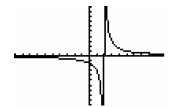
Example 2: Sketch the graph of  .
.
1. There are no y-intercepts. When x=0, we arrive at an undefined value
2. X-intercept is at (1/2,0). This is found by setting our numerator equal to 0.
3. There is a vertical asymptote at x=0. (found by setting the denominator equal
to 0)
4. There is a horizontal asymptote at y=2. (we look at the coefficients since
the
degree of the numerator is equal to the degree of the denominator)
5. Additional points can include (4,2.25), (-1,3), (1/4, -2), (4, 1.75). By
plotting all
of this, we obtain the following graph (done on the calculator):
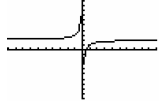
Example 3: Sketch the graph of
 .
.
1. Y-intercept is at (0,0)
2. X-intercept is at (0,0)
3. There is a vertical asymptote at x=-2 and at x=1. (found by setting the
denominator equal to 0)
4. There is a horizontal asymptote at y=0, since the degree of the numerator is
less
than the degree of the denominator
6. Additional points can include (-3,1.5), (-1,1), (2, 1), (3, 0.6). By plotting
all of
this, we obtain the following graph (done on the calculator):
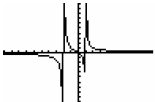
Example 4: Sketch the graph of  .
.
1. Y-intercept is at (0, -1/4)
2. X-intercepts are at (-1,0) and (1,0)
3. There are no vertical asymptotes. Setting the denominator equal to 0 yields
an
imaginary solution.
4. There is a horizontal asymptote at y=1. (we look at the coefficients since
the
degree of the numerator is equal to the degree of the denominator)
5. Additional points can include (-4, 3/4), (-2, 3/8), (2, 3/8), (4, 3/4). By
plotting all of
this, we obtain the following graph (done on the calculator):
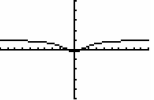
Definition (Oblique / Slant Asymptotes): If the degree of the numerator
is one greater
than the degree of the denominator, we have an oblique asymptote. We can find it
by
dividing the numerator by the denominator (use polynomial and/or synthetic
division).
Example 5: Find the oblique asymptotes of the function ( .
.
Solution: Since the degree of the numerator is one greater than the degree of
the
denominator, we have an oblique asymptote. We can divide by using synthetic
division

Therefore, , and we
have an oblique asymptote at y=x-2.
, and we
have an oblique asymptote at y=x-2.
Example 6: Find all asymptotes of the function
 .
.
Solution: Let’s look at the asymptotes separately…
Horizontal Asymptote: Since the degree of the numerator is greater than
the
degree of the denominator, there are no horizontal asymptotes.
Vertical Asymptotes: We set the denominator equal to 0. It can easily be
seen
that  , so we must have a vertical asymptote
at x=1.
, so we must have a vertical asymptote
at x=1.
Oblique Asymptote: Since the degree of the numerator is one greater than
the
denominator, we must have an oblique asymptote. We can use synthetic division
and divide out the factor ( x −1) twice, or we can use polynomial division
(recommended).
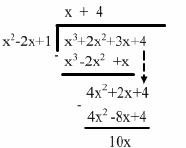
Therefore, we have an oblique asymptote at y=x+4.


